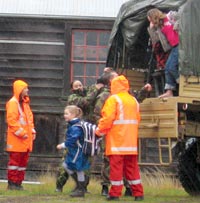Evacuation
Note: Newer information on this topic is available on the Get Ready website page - Have to evacuate.

In some situations you may be forced to evacuate your home, office, school or neighbourhood at short notice.
Before an evacuation
- Find out about your community’s warning systems and evacuation routes from civil defence emergency management staff at your local council.
- Consider your transportation options in case you have to evacuate. If you do not own or drive a car, ask emergency management staff about plans for people without private vehicles.
- Know which local radio stations to listen to during an event for announcements from your local emergency management officials.
- Discuss and practice your evacuation plans with everyone in the household.
- Make in-case-of-evacuation arrangements with friends or relatives in your neighbourhood as well as outside the area you are in.
- Know the evacuation routes you could take and plan several evacuation routes in case roads are damaged or blocked.
- Know where the emergency or welfare shelter locations are in your community
- If you have pets, domestic animals or livestock, include them in your emergency plans.
- If there is a possibility of an evacuation, fill your car’s fuel tank. Keep in mind that if there are power cuts in an event, fuel stations may not be able to operate pumps.
If you're in an area being evacuated
- Listen to your local radio stations as emergency management officials will be broadcasting the most appropriate advice for your community and situation.
- Evacuate quickly if told to do so by authorities. Take your getaway kit with you. If you are outside the evacuation zone when a warning is issued, do not go into an at-risk area to collect your belongings.
- If there is time, secure your home as you normally would when leaving for an extended period.
- Turn off electricity and water at the mains if there is time. Do not turn off natural gas unless you smell a leak or hear a blowing or hissing sound, or are advised to do so by the authorities.
- Take your pets with you when you leave if you can safely do so.
- If you have livestock, evacuate your family and staff first. If there is time, move livestock and domestic animals to a safer area.
- In some emergency situations such as a tsunami or wildfire it is better to leave by foot than to drive or wait for transportation.
- Use travel routes specified by local authorities. Some areas may be impassable or dangerous so avoid shortcuts. Do not drive through moving water. If you come upon a barrier, follow posted detour signs.
